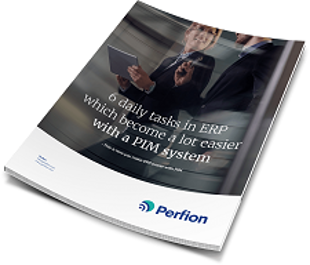
If you are manufacturing or managing products, you will probably recognize this situation:
A new series of products is to be launched, and they must be entered into the ERP system. It quickly becomes evident that an input field is missing for a completely new type of product data. Before you can create the products, the person responsible for the company's ERP has to create the new field, but if this person is really busy at the moment, you will just have to wait.
But there are other options that may make you far more self-sufficient and thus save time and resources for both you and the ERP person.
One possibility is to let the Product Information Management (PIM) system work together with the ERP system and thus turn the entire procedure upside down.
|
'Six daily tasks in ERP, which become much easier using a PIM system' |
Advantage no. 1:
You save time because you can do everything yourself – ERP adjustment is a thing of the past
Instead of a traditional process, in which you create the products in the ERP system first, you can let the products begin their life cycle in the PIM system. And why is that?
It is because the PIM system is a central location from which you can manage all kinds of product data (PIM and ERP work together 100%, so the PIM system can access the data in the ERP system). Thus, the PIM system is flexible and not limited to predefined input fields, so you can easily include all the product specifications. If a data field is missing, you can quickly and easily create it yourself – without any help from the ERP person.
Advantage no. 2:
New products are ready in the PIM system, waiting for the first buyer
Yet another advantage of starting off new produces in the PIM system is that it can function as a kind of sandbox for products that are not sold right away. It is not expedient to have products filling the ERP system before you have a buyer for them. The PIM allows you to work with the products and add all of the necessary information for advance marketing without affecting the ERP system.
While an ERP system includes transactional data that cannot be deleted and therefore remains there taking up space, you can quickly change and delete data in the PIM system. It is an advantage if you use the PIM system to prepare products for sale, and your marketing department can use all of the relevant data to market new products, even if they have not yet been created in the ERP system.
As soon as a product or product group is completely ready to be sold, it can easily be transferred to the ERP system.
Advantage no. 3:
With PIM, you can remove irrelevant data from the ERP system
When it comes down to it, the ERP system is, of course, only intended for processing transactional data. By creating all other product information in the PIM system, you ensure that the ERP system is kept free of irrelevant data.
Obtain more knowledge about PIM and ERP in this white paper
 Would you like to know even more about how a PIM system can help you to work with ERP data? Get the white paper: '6 daily tasks in ERP, which become a lot easier with a PIM system'
Would you like to know even more about how a PIM system can help you to work with ERP data? Get the white paper: '6 daily tasks in ERP, which become a lot easier with a PIM system'
Updated in February 2022
